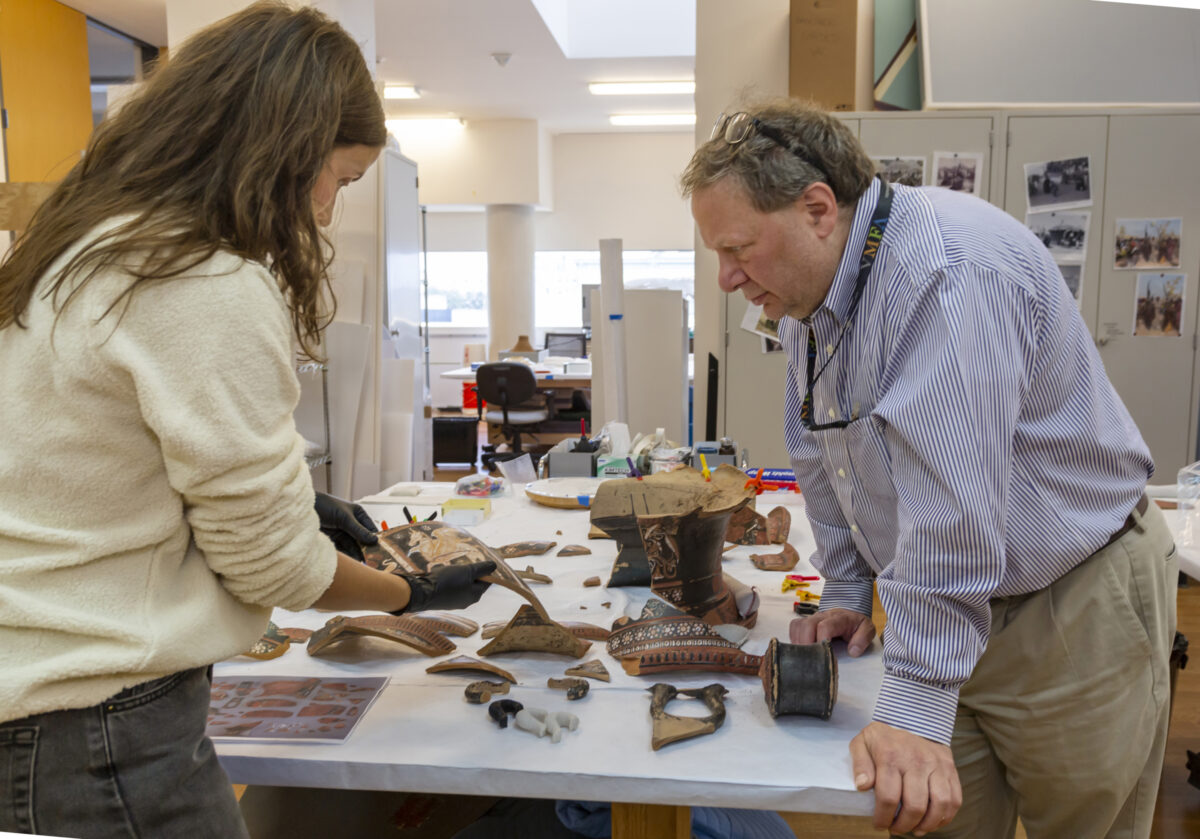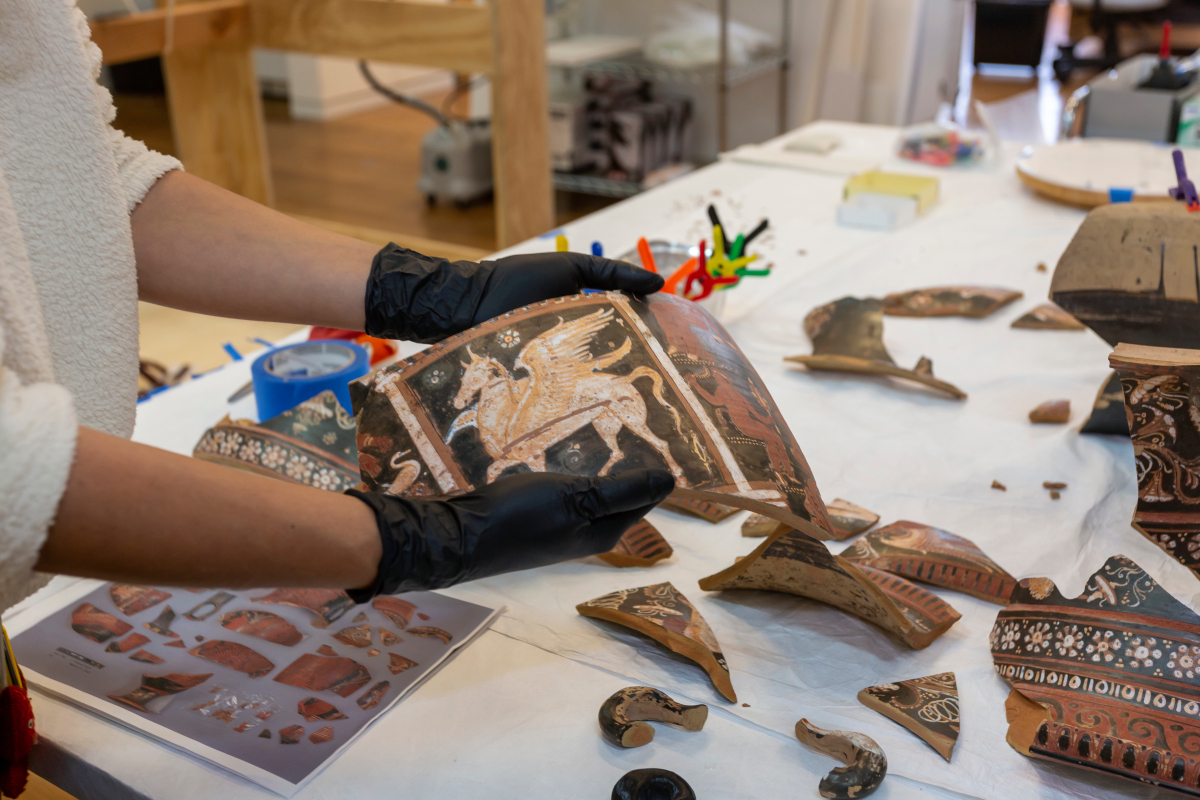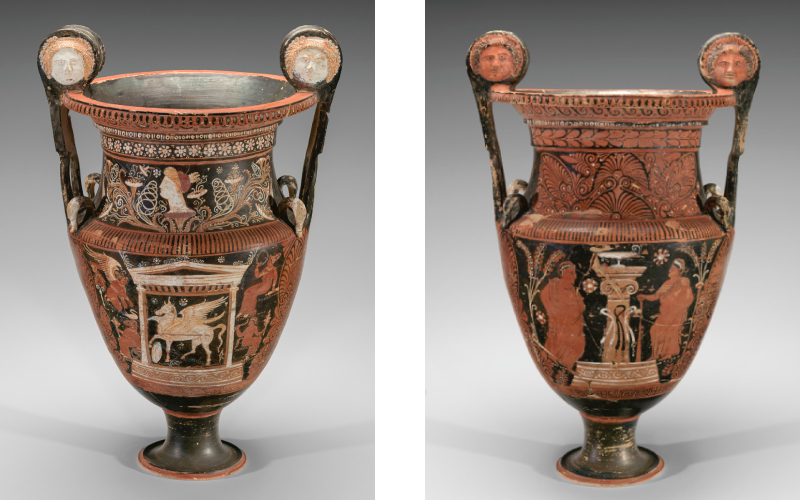This is the story of an ancient Greek vase that came to the Virginia Museum of Fine Arts as hundreds of fragments and small pieces and is now fully reassembled, conserved, and on view in the museum’s niche gallery in the Cochrane Atrium through June 5, 2023. And it’s all thanks to the generosity of Doug and Sharon Tinder; the detective work of Dr. Peter Schertz, VMFA’s Jack and Mary Ann Frable Curator of Ancient Art; and almost 300 hours of conservation work by Assistant Objects Conservator Skyler Jenkins.
Watch the time lapse video of VMFA’s conservation work, and read Dr. Schertz’s account of the fascinating story that began some 30 years ago with an insurance claim.
It does not happen often, but sometimes that broken vase in your garage, which no one had the heart to throw out, turns out to be a real treasure. That is certainly the case with one of VMFA’s newest ancient Greek vases. It is a beautiful and mysterious Apulian volute krater, an ancient bowl for mixing wine and water. The vase arrived in 35 large fragments and hundreds of small pieces. They had been in a box in a Richmond garage for more than 30 years when in 2021 Doug Tinder contacted VMFA through its Curatorial Inquiries page to ask if we would be interested in an ancient Greek krater as a donation.

In VMFA’s Goode Conservation Studios with curator, Peter Schertz (right), and conservator, Skyler Jenkins (left)
Of course, the first step was to clarify whether the vase was ancient, and even a quick glance at photographs indicated it was. Then, of course, we wanted to know the story—how did this 2300-year-old vessel come to be in a garage in Richmond? Mr. Tinder explained that he had previously worked for Maryland Casualty Insurance, which had insured the vase in 1990; the vase broke, a claim was paid, and ownership of the pieces passed to Maryland Casualty—right around the time it merged with Zurich International. Mr. Tinder helped close Maryland Casualty’s local office, and rather than throw out the fragments, he took them home—almost certainly with verbal permission but nothing in writing. If he took the fragments from the trash, the laws of salvage would apply; if he took them from the storeroom, potentially other laws would apply. To clarify the ownership, I contacted Zurich International to make sure they had no record of the vase or claim to ownership. They did not!
But even if Mr. Tinder owned the vase, it was not clear if VMFA, which adheres to the acquisition guidelines of the Association of Art Museum Directors, could accept it. When did this vase become known? Following up on information from Mr. Tinder, I found the same vase in a Sotheby’s auction catalogue from 1990, but Sotheby’s said that the vase had not sold in that auction. Back to the Sotheby’s catalogue, and there it was in a 1989 auction, when it did sell to Maryland Casualty’s client.
The vase had also been sold in 1982 and had been published by Konrad Schauenburg and Dale Trendall in the 1980s, but there was no record of the vase from before 1982. Before VMFA was comfortable accepting this kind donation, the registrar and I wrote a letter to the Italian government to ask if they had any further information on the vase or had any objections to the museum accepting the donation; when the Italians answered that VMFA could accept the vase, Mr. Tinder and his wife, Sharon, donated it.

Inspecting the many pieces to the puzzle, including the vase’s magnificent depiction of Pegasus
The vase, as dozens of fragments, was now in the care of our amazing conservation team that works out of VMFA’s David and Susan Goode Conservation Studios. Assistant Objects Conservator Skyler Jenkins took on the job of reconstructing the vase. Jenkins first spent over 100 hours just cleaning the pieces and removing old glues (superglue and something like Elmer’s glue). She then spent months reconstructing the vase. The process involved assembling the pieces and then having to take them apart again to correct the alignments. She discovered that one of the four duck-head terminals at the base of the handles was missing, so the museum worked with Professor Bernard Means and his students at Virginia Commonwealth University’s Virtual Curation Laboratory to scan a surviving terminal and make a 3D print of it; this print served as the basis for a mold for a new terminal. In keeping with current conservation practices, none of the materials used to reconstruct the vase interact with the original ceramic or its surfaces and all repairs can be undone if future conservation is required.

Red-Figured Volute Krater, late 3rd century BC, Greek (South Italian, Apulian), terracotta.
Virginia Museum of Fine Arts, Adolph D. and Wilkins C. Williams Fund
The vase, titled Red-Figured Volute Krater, is a thrilling addition to VMFA’s strong holdings of South Italian vases, especially as the form is very common but, until now, was not represented in our collection. The exuberant use of color is typical of Apulian vases as are the ornamental motifs and crowd of figures on the front and less carefully rendered figures (and a column) on the back. The central scene, Pegasus in a naiskos (a type of funeral structure), has no known parallel and its significance is uncertain. On either side are seated figures, on the left Eros and a woman, on the right a woman and a nude youth. Perhaps the most charming and delicately worked part of the decoration is the bust of the woman on the neck surrounded by floral motifs.
From fragments to fully reassembled, conserved, and on view—the mystery is solved and the puzzle complete, and we’re thrilled to share this vase’s story and beauty with VMFA visitors.